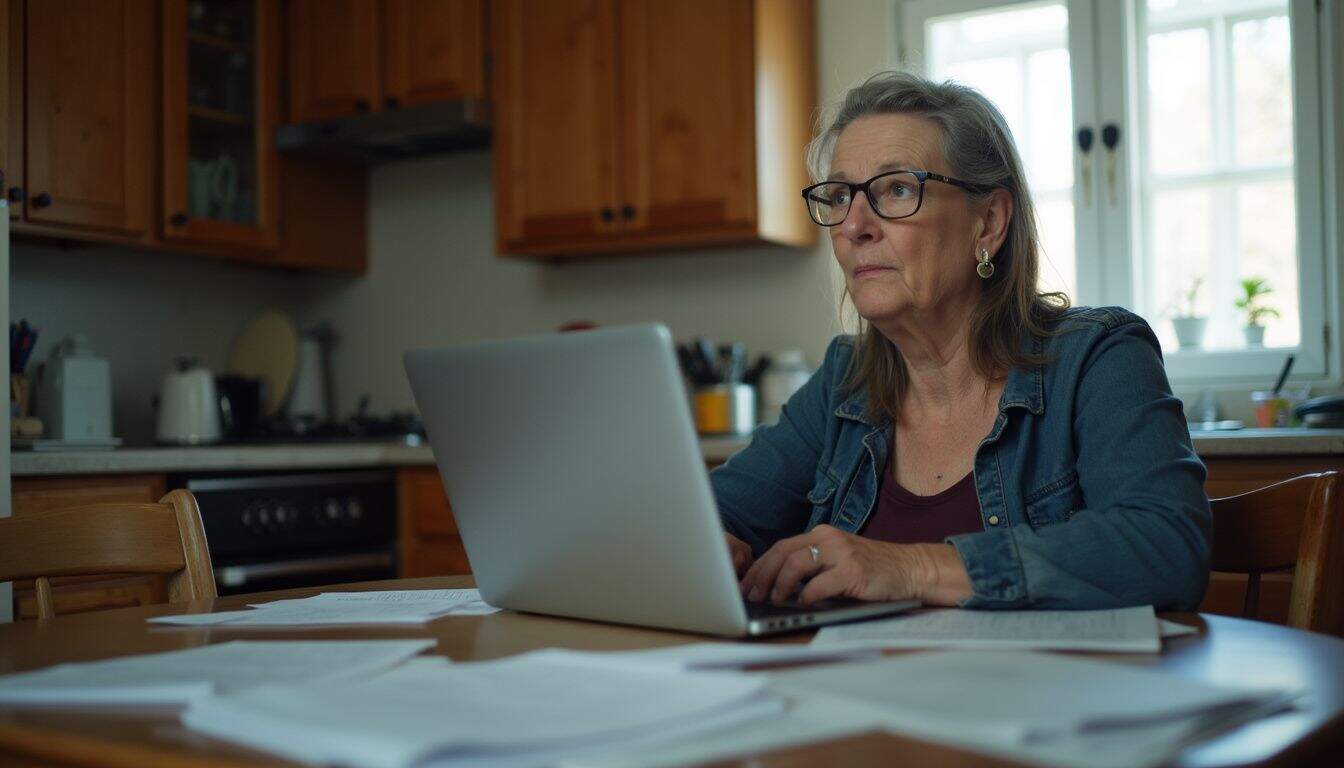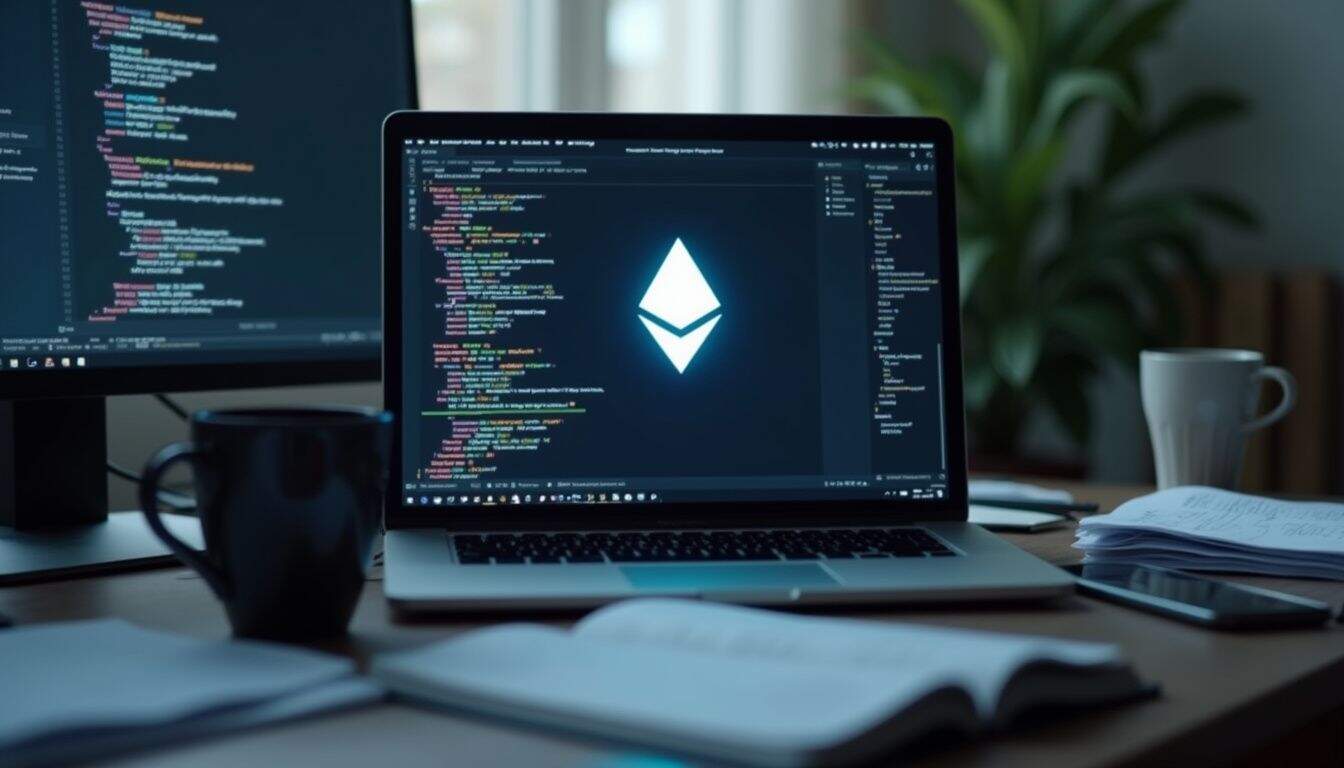Ever feel like you’re trying to learn a new language when your kids start talking about Bitcoin, crypto wallets, or the latest news on blockchain technology?
You’re not the only one. Many of us have heard stories about cryptocurrency investment and just want to keep our families safe from crypto fraud, but it feels overwhelming to even start.
Here’s a little secret I discovered: You don’t need to be a tech expert to understand this stuff. Anyone can get the hang of it, even between school runs and busy work schedules.
This cryptocurrency guide for parents is here to help. I’m going to walk you through everything in simple, friendly steps. We’ll break down the confusing terms and focus on what really matters for your family’s financial future.
Key Takeaways
Cryptocurrency is a digital currency that uses blockchain technology for secure, direct transactions without a bank. Bitcoin, created by Satoshi Nakamoto in 2009, has a fixed supply of 21 million coins and has seen its price soar.
You can invest for your child’s future using custodial crypto accounts from providers like EarlyBird or by contributing to a Roth IRA. The IRS allows you to gift up to $19,000 in crypto tax-free per child each year for 2025 and 2026.
Beyond Bitcoin, major cryptocurrencies include Ethereum (ETH), Solana (SOL), Tether (USDT), and Binance Coin (BNB). Each one offers unique features, from powering apps to providing price stability.
The crypto market is known for its volatility, and security is a major concern. According to a 2025 report from Chainalysis, illicit crypto addresses received tens of billions of dollars in 2024. It’s essential for families to use strong passphrases and two-factor authentication to stay safe.
The IRS treats cryptocurrency as property. Every sale, trade, or gift over the annual exclusion amount ($19,000 for 2025) needs to be reported. Gains on crypto held less than a year are taxed as regular income, while long-term gains (held over a year) are taxed at rates up to 20%.
Table of Contents
What Is Cryptocurrency?

Think of cryptocurrency as digital cash. It allows people to buy things, send money, or invest without going through traditional banks. It all runs on a technology called the blockchain, which is like a public record book that keeps track of every single transaction for everyone to see.
What does cryptocurrency mean?

A digital currency like Bitcoin or Ethereum is purely electronic, existing only on computers. It uses a special kind of coding called cryptography to keep it secure, which prevents people from making fake copies.
When Satoshi Nakamoto launched Bitcoin in 2009, it kicked off a huge wave of other virtual currencies, often called altcoins. You might have heard of some, like Litecoin or Ripple.
Instead of relying on banks, people can send these crypto assets directly to each other over online networks. Every transaction is recorded on a public list called the blockchain ledger, which is open for anyone to view. This makes the whole system transparent.
To keep your cryptocurrency safe, you use digital wallets. These can be software on your phone or computer, or even special hardware wallets that act like a super-secure digital purse. When your kids talk about “crypto tokens,” they’re just referring to the units of value, like digital coins, that are traded using this technology. No physical money is involved, it’s all software tracked by a global network.
As its creator Satoshi Nakamoto said, Bitcoin was designed to allow online payments to be sent directly from one party to another without going through a financial institution.
How does blockchain technology work?

Imagine a digital chain made of secure blocks. Each block holds transaction information that, once added, can’t be changed. This chain is managed by thousands of computers all over the world, creating a shared ledger that isn’t owned by any single person or company.
Think of it like a shared neighborhood notebook where every resident has an identical, up-to-date copy of all the neighborhood’s transactions. When a new transaction happens, it’s broadcast to the network. Special users called miners solve complex math problems to verify the transaction and add it as a new block to the chain.
Once a block is added, the information becomes a permanent part of the record. This structure provides incredible transparency and protection from fraud.
This technology is now used for much more than just digital currency. For instance, major companies use it to track products in their supply chains, manage healthcare records, and even create secure voting systems.
You might see it in action with Solana’s super-fast blockchain, which powers things like online gaming platforms that offer VIP rewards, or with Ethereum, which is the foundation for many decentralized apps you hear about online.
Why Parents Should Understand Cryptocurrency

Cryptocurrency is definitely changing the way we think about and use money. As a parent, getting a handle on digital currency can open up new opportunities for making smart financial choices for your family’s future.
Why is cryptocurrency important in today’s finance?

One of the biggest differences is that crypto markets never close. Unlike the stock market, which operates on a 9-to-5 schedule, you can trade digital currency 24/7. Money is no longer limited to a banker’s schedule.
I remember my own teen checking his crypto wallet balance before school one morning, it was quite a wake-up call!
You’ll often see Bitcoin’s price making big moves while the traditional stock market is quiet, which really highlights how cryptocurrency volatility is a different beast than stocks or bonds. A 2024 survey by Policygenius showed that 20% of Gen Zers own crypto, compared to just 18% who own stocks. This shows how important this asset class is to the next generation.
Seeing these trends online gets kids asking smart questions, which is a great opportunity for financial education. As blockchain technology becomes a more common topic, it opens up a new way for families to talk about investing together.
I once told my daughter, “This isn’t like Monopoly money, there are real dollars behind those digital coins.” It really clicked for her.
What are the investment opportunities for parents?

For parents looking to invest in digital currency for their kids, one popular option is opening custodial accounts. Platforms like EarlyBird and UNest are designed specifically for this, allowing you to manage crypto assets for your children until they’re adults. You could also use a Roth IRA, where up to $7,000 of a teen’s annual earned income can grow tax-free.
How much should you invest? A well-known Yale study suggested a 6% portfolio allocation to Bitcoin for smart asset allocation, while a 2021 article in TIME magazine suggested it could be as high as 15%. Of course, you can also get exposure through cryptocurrency-related stocks and ETFs, or diversify with other assets like real estate, collectibles, or even precious metals like gold, which has performed well since late 2024.
I sat down with my daughter to research how blockchain technology works, and we picked out our first few coins together on a crypto exchange app. An important lesson we learned was that setting clear rules about passwords and security was just as critical as choosing which coin to buy.
For a personal story from another mom who took the plunge, you can check out Becoming a Crypto Mom. Always stay updated on cryptocurrency regulations and chat with a financial advisor before making big moves. The cryptocurrency volatility is real!
Leading Cryptocurrencies You Should Know

You’ve probably heard of Bitcoin and Ethereum, as they’ve completely changed how people think about digital money. These major cryptos are available on nearly all cryptocurrency exchanges, and each offers something unique.
What is Bitcoin?

Bitcoin first appeared in 2009, created by the mysterious Satoshi Nakamoto. One of its defining features is its limited supply, there will only ever be 21 million coins. Each bitcoin can be divided into 100 million smaller units called satoshis.
As of August 2025, a single Bitcoin was trading for over $124,000. To put its growth in perspective, back in December 2017, its price surged to nearly $18,000, which captured the attention of thousands of young investors.
A financial advisor at a school event once put it perfectly: “Think of Bitcoin as digital gold you can buy on your phone.”
To keep their bitcoin secure, people use digital wallets and private keys. Today, user-friendly apps like Coinbase and Kraken make buying it almost as easy as ordering shoes online. Many major companies like Microsoft and AT&T now accept Bitcoin for payments, making it more useful for real-world purchases.
When families are considering adding cryptocurrency to their portfolio, they often compare it to other assets they own, like real estate, stocks, or even gold. This helps them decide if it fits into their financial education plan for their kids’ savings.
What is Ethereum?

Launched in 2015 by a team led by Vitalik Buterin and Joe Lubin, Ethereum is more than just a digital currency. It’s a decentralized software platform that isn’t controlled by any single company. Its currency, Ether (ETH), is used for transactions within its ecosystem.
You can store your Ether in a crypto wallet and use it to interact with smart contracts, which are self-executing contracts with the terms of the agreement directly written into code. This technology powers everything from digital art (NFTs) to new forms of organizations called DAOs.
Since 2022, Ethereum has used a proof-of-stake method, which made the network much more energy-efficient. A major update in March 2024, called the Dencun upgrade, helped lower transaction costs and speed things up.
Unlike Bitcoin, Ethereum doesn’t have a fixed supply of coins. In May 2024, the market value of one ETH was around $3,735, according to cryptocurrency exchange data.
What are other major cryptocurrencies?

While Bitcoin and Ethereum get most of the headlines, there are many other important digital coins out there. Here are a few you should know:
- Tether (USDT): This is the largest “stablecoin,” which means its value is pegged to the U.S. dollar. Many people use it as a stable place to hold funds during times of high crypto volatility.
- Binance Coin (BNB): This coin powers the Binance ecosystem, one of the world’s largest cryptocurrency exchanges. Users often get trading fee discounts for using BNB.
- Solana (SOL): Known for its incredible speed and low fees, Solana is popular for gaming and decentralized finance. It can process up to 65,000 transactions per second. It also hosts many crypto games, including some with a $25K weekly raffle that attracts a lot of players.
- Cardano (ADA): Cardano stands out for its focus on sustainability and a research-driven approach. Its development is based on peer-reviewed academic research.
- XRP: Managed by Ripple Labs, XRP is designed to help banks and financial institutions move money across borders quickly and at a very low cost.
- USD Coin (USDC): Like Tether, USDC is another major stablecoin backed by the U.S. dollar, offering a reliable store of value in the fluctuating crypto market.
- Avalanche (AVAX): AVAX is known for its fast transaction finality, making it a strong platform for decentralized apps that require quick confirmations.
- Dogecoin (DOGE): What began as a meme-inspired joke has become a top cryptocurrency, largely thanks to a vibrant community and shoutouts from figures like Elon Musk.
- Shiba Inu (SHIB): Following in Dogecoin’s footsteps, SHIB has expanded beyond being a meme coin by developing its own decentralized exchange and NFT marketplace.
How to Buy Cryptocurrency

Ready to take the first step? Buying digital currency usually starts with choosing a trusted cryptocurrency exchange, like Coinbase or Gemini. From there, setting up a crypto wallet is often as simple as creating a new email account.
How do I choose a cryptocurrency exchange or broker?
First, you’ll want to find a cryptocurrency exchange that feels right for you. Look for platforms that support your preferred payment method, whether that’s a direct bank transfer or a debit card. Centralized exchanges like Coinbase, Gemini, and Kraken are popular choices because they follow strict government regulations, including “Know Your Customer” (KYC) rules.
Some platforms, like Robinhood or SoFi, let you buy crypto tokens but might not allow you to move your coins to your own personal crypto wallet. This is a key detail, as having your own wallet gives you full control over your assets.
Before you sign up, always check a few key things:
- Fees: How much do they charge for buying, selling, and transferring crypto?
- Security: What measures do they have in place, like two-factor authentication and insurance for digital assets?
- Ease of Use: Is the website or app intuitive and easy for a beginner to use?
As financial advisor Jenna Lee says, “Find an exchange that fits your budget and keeps your peace of mind.”
How do I set up a cryptocurrency account?

Once you’ve picked a reliable cryptocurrency exchange, the setup process is pretty straightforward. Because of KYC regulations, you’ll need to be at least 18 years old to open an account. Be ready to provide some personal information and upload a photo of your ID, like a driver’s license. Some platforms may also ask for a selfie to verify it’s really you.
These steps are in place to prevent fraud and can feel a bit like airport security for your money, but they are crucial for keeping your account safe.
Next, you’ll connect a funding source, like your bank account, debit card, or credit card. A heads-up: using a credit card can sometimes be treated as a cash advance, which might come with extra fees. Wire transfers often have the lowest fees for larger deposits.
If you’re doing this with your kids in mind, you can look into opening custodial crypto accounts for minors as a great financial education tool. Most exchanges provide a built-in crypto wallet where your Bitcoin or Ethereum will be stored right after you buy it.
And remember, every purchase is considered a taxable event by the IRS, so it’s a good idea to keep clear records from the start.
How do I place a crypto order?
After your account is funded and your identity is verified, you’re ready to buy! Simply choose the digital currency you’re interested in, like Bitcoin or Ethereum.
You’ll then click “Buy” and enter the amount you want to invest. You can start small, even with just $5 or $10. Once you confirm the details, you submit your order, and the cryptocurrency exchange will handle the rest.
It’s important to read the fine print. Some platforms may only let you hold your crypto in their built-in wallet, while others allow you to transfer it out to a personal wallet for better security. Trading fees can also be a surprise for newcomers, as they often work differently than traditional stock brokerage fees.
For maximum security, many people choose to move their crypto assets to a cold wallet, which is a hardware device that isn’t connected to the internet. I did this with my son’s first $25 investment in Litecoin, it just gave me more peace of mind! From there, you can monitor your investment performance through the platform’s dashboard.
Investing in Cryptocurrency for Your Child’s Future

Setting up a crypto wallet for your child can be an exciting way to teach them about a new kind of savings. It offers possibilities that traditional bank accounts or custodial accounts just can’t match. Let’s explore how this unique financial investment could help shape your family’s future.
What are the benefits of early crypto investments?
Starting with crypto early can give your kids a big head start on their financial literacy and digital skills. By managing even a small amount of cryptocurrency, they learn firsthand about digital currency, blockchain technology, and the importance of online security.
This is becoming more relevant every day. According to a 2025 Gemini report, more than half of Gen Z already owns crypto. This shows a clear shift in how younger generations are building wealth.
Using apps like EarlyBird or Step can turn these into practical, hands-on lessons about investing. Through custodial accounts, you can teach them how to save for long-term goals like college or a down payment on a house.
Because cryptocurrency is decentralized, it often has lower fees than traditional banks and is accessible globally. This means that even families without access to traditional investment options can get their kids started. Investing a small amount allows them to learn about risk and reward in a controlled way, much like they would with stocks, but with more immediate feedback.
How can cryptocurrency be used for education savings?
Parents can use custodial accounts, often structured as a Uniform Gifts to Minors Act (UGMA) account, to hold digital currency like Bitcoin or Ethereum for their children. These accounts are managed by the parent until the child reaches the age of majority, which is typically 18 or 21.
The IRS has specific rules for gifting. For 2025, you can give up to $19,000 per year to each child without having to file a gift tax return. If you and your spouse gift together, that amount doubles to $38,000 per child. Any gifts above this annual exclusion amount must be reported on IRS Form 709.
Another great strategy is to invest a child’s earned income (up to $7,000 per year) into a Roth IRA, which can offer long-term tax-free growth for future education expenses. Many financial advisors now suggest a diversified portfolio that includes both traditional assets like stocks and alternative ones like cryptocurrency. Some platforms, like EarlyBird, even offer a small crypto bonus when you set up your first account.
How to Talk to Your Kids About Cryptocurrency

Trying to explain a crypto wallet? Try comparing it to their piggy bank. You might be surprised how much easier these tricky money conversations can become when you use simple, relatable examples. Keep reading for some tips that have worked for me.
How can I simplify cryptocurrency concepts for kids?
When I first talked to my daughter about this, I started with something she already knew. I held up a few coins and said, “This is money you can touch.” Then, I pointed to her piggy bank and called it a “wallet” for her cash. Using these simple ideas as a starting point makes the digital concepts much less intimidating.
To introduce Bitcoin, I called it “digital gold” and explained that it’s rare, just like real gold. I told her there will only ever be 21 million bitcoins in the whole world, unlike dollar bills, which can always be printed. My son’s eyes lit up when he heard that!
For blockchain technology, we built a tower with Legos. I explained that each block was like a transaction, and once it was added to the tower, it couldn’t be moved or changed. She got it right away: it’s like writing in pen instead of pencil. Using visuals can be a huge help.
When they asked about crypto wallets or how to buy Bitcoin on cryptocurrency exchanges, we looked up the answers together. Letting them guide the discovery process helps them learn real-world financial skills without getting bogged down in technical jargon.
How do I relate crypto to real-world finance for children?
Start with what they know. Use physical cash at the grocery store to explain basic transactions, then move on to concepts like debit cards or mobile payments. This helps bridge the gap between tangible money and digital money.
You can compare paper money, also known as fiat currency, with a digital currency like Bitcoin. Many kids are already familiar with virtual coins from video games like Roblox. Explain that real cryptocurrencies work outside of games and have actual value in the real world.
A great analogy is to describe a crypto wallet app as a digital piggy bank that lives on your phone. You can even show them price charts of major cryptocurrencies to talk about cryptocurrency volatility. Explain that prices can go up and down much faster than the money in their savings account.
Encourage them to research different crypto assets with you. This is a great way for you both to learn about different investment opportunities and how to use a trusted cryptocurrency exchange safely.
How can I encourage responsible financial habits in kids?
Connecting digital money to everyday financial decisions is key. I started a simple exercise with my daughter where we set up a savings jar for her allowance and a “pretend” crypto wallet with play money. We would check the balances together and talk about saving for a goal, like a new pair of shoes. This helped her understand the risk of putting all your eggs in one basket if prices suddenly drop.
Family “finance chats” can also be a fun weekend activity. We take turns picking a topic to research, whether it’s cryptocurrency volatility or how banks work. This keeps the kids engaged and helps them learn by doing.
Before we head out for the day, I always make sure our account logins and passwords are documented securely in case of an emergency. Building these simple routines helps teach responsibility and shows them that making smart choices now will prepare them for the future.
Risks and Considerations for Parents

It’s no secret that crypto volatility can cause prices to swing dramatically. On top of that, it’s incredibly important to protect your private keys and crypto wallet from online hackers and scams at all times.
What are the volatility risks in cryptocurrency markets?
The price of a digital currency can change dramatically in a single day. In fact, Bitcoin lost over 75% of its value during 2022. This kind of volatility makes it nearly impossible for even seasoned investors to predict what will happen next.
Unlike money in a traditional bank account, your crypto investments are not protected by deposit insurance. This means that if something goes wrong, you could lose your entire investment.
Because of these risks, many parents view cryptocurrency as a speculative investment. These digital assets don’t have any physical backing, like real estate or gold, and aren’t considered legal tender in most places. A single news event or a change in government regulations can cause prices to plummet before you’ve even had your morning coffee.
How can I protect against security risks and scams?
While market swings are a big concern, scams and hacks are an even more immediate threat. According to research from Chainalysis, over $12.4 billion was stolen in 2024 alone, with “pig-butchering” romance scams making up a third of all crypto fraud. Here are a few essential safety tips:
- Use Strong Passwords: Create long, unique passphrases (at least 15 characters) for every crypto wallet and exchange account.
- Enable Multi-Factor Authentication (MFA): This adds a critical layer of security that requires a second form of verification, like a code sent to your phone.
- Beware of Common Scams: Teach your family to recognize red flags, like “pig butchering” (romance and investment fraud), fake celebrity endorsements using AI deepfakes, and “rug pull” scams where developers abandon a project after taking investors’ money.
- Consider a Hardware Wallet: For long-term storage, a hardware wallet (also called a cold wallet) from a trusted brand like Ledger or Trezor keeps your private keys offline and safe from hackers.
I once caught my daughter sharing our general location on a message board with someone who claimed to be a “crypto expert.” It was a scary reminder of how easily kids can overshare online. Always teach your family to be skeptical and to verify who
they’re talking to before sharing any personal information.
What are the legal and tax implications of crypto?
The IRS views digital currency as property, not cash, which has important tax implications. Any time you sell, trade, or use cryptocurrency to buy something, you have to report it on your tax return.
Here’s a quick breakdown of how it works:
Capital Gains Tax:
- If you hold your crypto for less than a year before selling, any profit is considered a short-term capital gain and is taxed at your regular income tax rate.
- If you hold it for more than a year, it’s a long-term capital gain, which is taxed at lower rates: 0%, 15%, or 20%, depending on your total income. For 2025, a married couple filing jointly with a taxable income of $96,700 or less would pay 0% on long-term gains.
Gifting Crypto:
- For 2025, you can gift up to $19,000 per person without needing to report it.
- If you give more than that, you’ll need to file IRS Form 709.
Keeping good records of all your transactions is essential. To make this easier, you can use specialized crypto tax software like Koinly or CoinTracker. These tools can connect to your exchange accounts and generate the reports you need for tax season.
Alternatives to Cryptocurrency Investments

If the crypto world feels a bit too wild, there are plenty of traditional investment options to consider. Many parents feel more comfortable with familiar choices like real estate or precious metals. It’s always a good idea to talk with a financial advisor to figure out what best fits your family’s financial goals.
What traditional investment options are available?
For those looking for more stability, there are many time-tested investment paths. These often form the foundation of a balanced financial plan.
- Stocks: Buying stocks means you own a small piece of a company, like Apple or Disney. They offer potential for growth but also come with market risk.
- Bonds: When you buy a bond, you’re essentially lending money to a government or a large corporation. In return, you receive regular interest payments. Bonds are generally considered lower risk than stocks.
- Real Estate: Owning property, whether it’s your home or a rental, can be a solid long-term investment that often keeps pace with inflation.
- Precious Metals: Assets like gold have been a reliable store of value for centuries and have seen a strong performance since late 2024.
If you’re still interested in the crypto industry but want to avoid buying coins directly, you could look into crypto-related stocks or Exchange-Traded Funds (ETFs) like the ProShares Bitcoin Strategy ETF (BITO). These options allow you to invest in blockchain technology without the need to manage a crypto wallet yourself. A good financial advisor can help you mix these traditional options to balance out the risk from more volatile assets.
How does crypto compare with other financial products?
It can be helpful to see how cryptocurrency stacks up against other common investment choices. Here’s a simple table to compare the features, risks, and benefits for your family’s finances:
| Product | Main Features | Risks | Ease of Access |
|---|---|---|---|
| Cryptocurrency (e.g., Bitcoin, Ethereum) | Runs on decentralized networks, offers fast global transfers, and is available 24/7. | High price volatility (Bitcoin lost over 75% of its value in 2022), risks of hacking and scams, and an evolving regulatory landscape. | Easy to buy on exchanges like Coinbase or Gemini with a simple verification process. |
| Mutual Funds | A managed pool of money invested in a diverse range of stocks and bonds, offering built-in diversification. | Management fees can reduce returns, and their value is still subject to overall market fluctuations. | Widely available through banks, brokerage firms, and online investment platforms. |
| Government Bonds | A low-risk investment where you lend money to the government in exchange for steady interest payments. | Returns are often low and may not keep up with inflation. Your money is typically locked in for a set period. | Can be purchased directly from the government or through most banks and brokers. |
| Real Estate | A physical asset that can provide rental income and appreciate in value over time, often acting as a hedge against inflation. | Requires a large upfront investment, is not easily sold (illiquid), and comes with ongoing costs like taxes and maintenance. | Requires working with real estate agents, lenders, and involves a lot of paperwork. |
Tips for Parents Navigating the Crypto Space

My best advice is to start small, ask a ton of questions, and don’t be afraid to talk to a financial advisor who gets the digital currency space. Take some time to learn how a crypto wallet and a trustworthy cryptocurrency exchange work before you invest any real money.
How can I stay informed about cryptocurrency trends?
Keeping up with the fast-moving world of crypto can feel like a full-time job, but there are some great resources that make it manageable. I’ve found it helpful to follow a few credible news outlets like CoinDesk and Cointelegraph for reliable reporting.
If you prefer listening, podcasts like Laura Shin’s “Unchained” or “Bankless” are fantastic for deeper insights. For visual learners, the Coin Bureau YouTube channel does a great job of breaking down complex topics in an easy-to-understand way.
Subscribing to industry newsletters can also be a great way to get curated information delivered right to your inbox. And don’t underestimate social media, following respected figures like Vitalik Buterin (co-founder of Ethereum) or Cathie Wood on platforms like X can provide quick updates.
Finally, joining online communities on platforms like Reddit or even local meetups can be a great way to learn from others’ experiences. Just remember to always be critical and verify information from multiple sources.
Why should I start with small crypto investments?
Dipping your toes in with small crypto investments is the perfect way to learn without taking on huge financial risks. It allows you and your family to get a feel for how blockchain technology actually works, whether you’re using a simple crypto wallet or a custodial account.
When there’s only a small amount of money on the line, it creates a safe space for everyone to learn together. You can make those beginner mistakes without the stress. It also helps you gauge your own comfort level with crypto volatility. If seeing a small investment go up and down makes you nervous, you’ll know that this might not be the right path for your life savings.
This approach naturally encourages good habits, like setting clear rules for buying and selling and tracking your investments responsibly. It turns investing into a valuable lesson in financial literacy for your kids, giving them a chance to learn and grow before they start handling larger sums of money.
How can I use crypto to teach financial literacy?
Bringing digital currency into your everyday money lessons can give your kids invaluable, hands-on experience. A great way to start is by showing them how a cryptocurrency wallet works or letting them track a small investment in a custodial account through an app like CryptoMom.
You can walk them through a real crypto transaction, no matter how small. This is a perfect opportunity to talk about blockchain technology, transaction fees, the importance of strong passwords, and other security risks.
Discussing crypto volatility is also a fantastic lesson. You can compare the price swings of Bitcoin to the more stable value of fiat currency or even the price of gold. Gifting them a small amount of crypto can spark their interest and teach them about risk management and even the tax rules that apply to their accounts.
Platforms like the CryptoMom App even allow you to set up tax-advantaged gifting strategies, turning a modern investment into a timeless lesson about saving for the future.
How Will Cryptocurrency Transform by 2025?

Looking ahead, the crypto world is set to become even more integrated into our daily lives. Smart contracts and decentralized applications will likely become more mainstream. It’s possible that more kids will be familiar with DAOs, which are community-led organizations, than their favorite cartoons.
We can expect crypto wallet security to improve with the help of advanced AI that can detect scams more quickly. This will make it safer and easier for families to manage their digital assets.
Major financial institutions are already exploring ways to use blockchain technology for things like real estate and other alternative assets. As regulators introduce clearer rules, using cryptocurrency for custodial accounts and long-term savings will likely become a more common and secure option.
Innovations like Layer-2 rollups and zero-knowledge proofs are already making transactions faster and cheaper on major cryptocurrency exchanges. In the near future, we could see digital coins being used for everything from paying college tuition to saving for retirement, with seamless exchanges between crypto and fiat currency.
As this technology grows, so will the educational resources around it. We can expect to see more schools and workshops teaching kids about digital assets, including how to spot phishing attempts and stay safe online. Clearer tax guidance will also make it easier for parents to manage their family’s investments and include digital assets in their estate planning.
People Also Ask
What is digital currency, and how does it differ from cash or gold?
Digital currency, like Bitcoin or Ethereum, is money that only exists online, and you access it with a secure digital or crypto wallet. Unlike the cash in your purse, it is not controlled by a central bank, and unlike gold, you can not physically hold it. It is all managed on a transparent public ledger called a blockchain.
How can parents teach financial literacy using cryptocurrency?
You can start with a hands-on approach by setting up a custodial account through services like UNest or Greenlight, which allow kids to own a small amount of crypto with your oversight. This provides a real-world lesson in crypto volatility, showing them how the value can change quickly compared to less risky assets. Use the Coinbase app to show them real-time price charts, making the concept of market changes easy to see.
Are there rules for children owning cryptocurrency?
Yes, since minors can’t open their own accounts on a cryptocurrency exchange, you will need to open a custodial account in their name. These accounts are managed by you until your child legally becomes an adult, which is typically at age 18 or 21 depending on your state’s cryptocurrency regulations.
Should families talk to a financial advisor before investing in cryptocurrencies?
It is a smart move to speak with a Certified Financial Planner (CFP) who understands digital assets before making a significant cryptocurrency investment. They can help you balance the risks with your family’s financial goals and ensure it fits into your broader estate planning. A good advisor helps you understand how this new asset class aligns with guidance from regulators like the SEC.
Can I include my child’s crypto holdings in my last will and testament?
Yes, you should absolutely include digital assets in your last will and testament, just like any other property.
What happens if someone passes away without a will holding digital assets?
If you pass away without a will, state intestacy laws will determine who inherits your assets, but your family may never be able to access the crypto if they do not have the private keys or crypto wallet passwords. This is why it is crucial to include clear instructions for your heirs in your estate planning documents. Without them, the assets could be lost forever in the digital world.
References
https://www.kaspersky.com/resource-center/definitions/what-is-cryptocurrency
https://www.investopedia.com/terms/b/blockchain.asp
https://parentzone.org.uk/article/cryptocurrency (2025-09-23)
https://raisingteenstoday.com/bitcoin-101-parents-guide-digital-currency-craze/ (2017-12-31)
https://www.investopedia.com/tech/most-important-cryptocurrencies-other-than-bitcoin/
https://www.nerdwallet.com/article/investing/how-to-buy-cryptocurrency (2025-10-22)
https://www.mydoh.ca/learn/money-101/investing/cryptocurrency-101-a-guide-for-parents-and-teens/
https://www.investopedia.com/investing-in-cryptocurrency-5215269
https://www.kidvestors.co/post/crypto-for-kids
https://online.se.edu/programs/cryptocurrency-education-student-parent-survey/ (2025-09-18)
https://www.safes.so/blogs/crypto-for-kids/
https://easyreadernews.com/how-to-teach-kids-about-crypto/ (2022-07-14)
https://www.kiplinger.com/personal-finance/kids-and-cryptocurrency (2022-11-30)
https://www.legacylawyeratsibleylaw.com/navigating-the-world-of-cryptocurrency-a-guide-for-parents-and-teens (2024-04-15)
https://www.ciro.ca/office-investor/understanding-risk/learn-about-risk-crypto-assets
https://brightadvisers.com/how-are-crypto-gains-taxed-a-step-by-step-guide-for-parents/
https://www.elibrary.imf.org/view/journals/001/2023/144/article-A001-en.xml
https://www.tandfonline.com/doi/full/10.1080/07360932.2024.2357364
https://journal.pandawan.id/b-front/article/download/690/504/3686
https://vocal.media/01/the-ultimate-guide-to-innovative-cryptocurrency-development-in-2025
